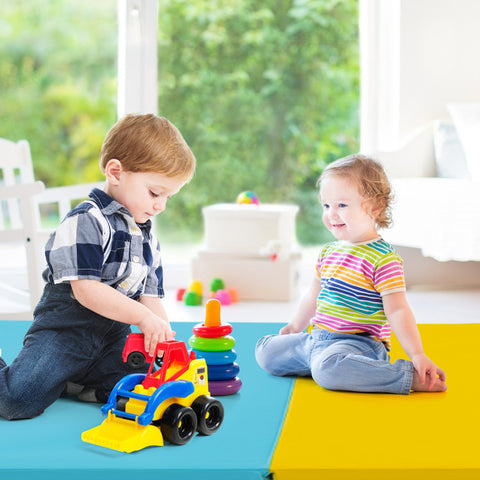News
The Science of Safety: How Foam Density Impacts Gymnastics Mat Performance
Behind every flawless gymnastics routine lies a silent partner, the mat. While its surface may seem simple, what’s inside defines everything: foam density.
Foam density determines how well a mat absorbs shock, supports stability, and prevents injuries. For gymnasts, choosing the correct density can be the difference between a safe landing and a painful one.
In this article, we explore the science, engineering, and importance of foam density in gymnastics mats and how it affects both performance and safety.
Understanding Foam Density in Gymnastics Mats
Foam density refers to how much material (mass) is packed into a cubic foot of foam, measured in pounds per cubic foot (PCF).
- Low-density foam: Softer, lighter, compresses easily.
- High-density foam: Firmer, heavier, and offers better impact resistance.
Both play essential roles in gymnastics mats, depending on the discipline and intensity of use.
Why Foam Density Matters
The right foam density balances comfort, shock absorption, and stability — three critical elements for gymnasts of all levels.
1- Shock Absorption
When a gymnast lands on a mat, kinetic energy transfers through the foam.
- High-quality foam absorbs this energy and disperses it evenly, reducing stress on joints and bones.
- Poor-density foam can lead to “bottoming out” — when the body hits the floor beneath the mat — increasing injury risk.
💡 Optimal shock absorption helps reduce impact-related injuries by up to 60%, according to sports safety research.
2- Surface Stability
Too soft, and gymnasts lose balance during landings. Too firm, and it feels like concrete.
Medium to high-density foams provide the best balance for professional use, especially in vaulting or tumbling exercises that demand strong footing.
3- Durability and Lifespan
Density also determines how well the mat resists compression over time.
- Low-density foams flatten or deform faster.
- High-density foams maintain structure and resilience for years, even under daily training conditions.
Investing in higher-density foam often means a longer-lasting, more cost-effective mat.
Types of Foam Used in Gymnastics Mats
1- Cross-Linked Polyethylene (XLPE) Foam
- Closed-cell structure, water-resistant, and firm.
- Ideal for tumbling, cheer, and advanced gymnastics due to strong impact resistance.
- Typically found in 8–12 PCF density range.
2- Polyurethane (PU) Foam
- Open-cell foam, softer, and more cushioned.
- Best for beginner mats, crash mats, and stretching areas.
- Ranges from 1.5–4 PCF density.
3- EVA Foam (Ethylene Vinyl Acetate)
- Combines flexibility and firmness.
- Excellent for home or multi-purpose mats requiring lightweight yet durable structure.
- Densities vary from 4–8 PCF.
Choosing the Right Density for Your Purpose
Each gymnastics activity has different needs:
| Activity Type | Recommended Foam Density | Purpose |
|---|---|---|
| Floor exercises | 4–6 PCF | Comfort and mild impact protection |
| Tumbling | 8–10 PCF | Strong support and rebound control |
| Vaulting | 10–12 PCF | Firm landings with high shock absorption |
| Crash or landing mats | 1.5–4 PCF | Deep cushioning for falls |
| Home training | 4–8 PCF | Balance between portability and comfort |
Engineering of Multi-Layer Foam Systems
Many professional gymnastics mats use multi-layer foam construction for better performance:
- Top layer (soft foam): Absorbs initial shock.
- Core layer (high-density foam): Provides stability and prevents bottoming out.
- Base layer (support foam): Enhances longevity and structure.
This combination ensures safety across a variety of movements and impact levels.
Impact of Foam Density on Athlete Performance
- Enhanced confidence: Gymnasts perform riskier moves knowing the mat provides reliable cushioning.
- Reduced fatigue: Proper shock absorption minimizes energy loss during training.
- Injury prevention: Protects ankles, knees, and lower back from repetitive stress.
A well-designed mat doesn’t just protect, it enhances skill progression by supporting better form and recovery.
Maintaining Foam Integrity Over Time
Even high-density foam needs care.
- Store mats flat and in cool, dry areas.
- Avoid exposing to direct sunlight or extreme temperatures.
- Rotate usage areas to prevent localized wear.
- Clean surfaces regularly to preserve the outer vinyl and prevent microbial growth.
Conclusion
Foam density is not just a technical term. it’s the foundation of safety and performance in gymnastics. Understanding how it works helps athletes, coaches, and gym owners choose mats that truly support the sport’s physical demands.
Whether you’re selecting a mat for professional training or home use, prioritize foam density that aligns with your activity level, weight, and skill intensity.
A well-constructed, high-density mat is more than an accessory, it’s a silent guardian of every leap, twist, and landing.
FAQs
Q1: What foam density is best for beginners?
Beginners should start with medium-density foam (around 4–6 PCF) for comfort and safety during low-impact training.
Q2: Can high-density mats be used at home?
Yes, but they’re heavier and less portable. For home setups, choose EVA or PU foams for an ideal balance of comfort and weight.
Q3: How long do gymnastics mats typically last?
With proper care, high-density mats last 5–10 years, while lower-density or frequently used mats may last 2–4 years.
Q4: Is firmer always better?
Not necessarily. The ideal firmness depends on the exercise type. Mats that are too firm can cause rebound injuries during falls.
Q5: Do foam densities affect mat certifications?
Yes. Safety certifications (like ASTM F1292 or EN 12503) often require mats to meet specific density and impact absorption standards.


